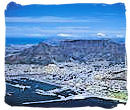 |
||||||||
Brief history of Apartheid in South AfricaThe painful truth about the history of apartheid in South Africa is that it started right from the day that the first Europeans set foot on South African soil.
Since that day the indigenous Khoi and San people and later the black peoplehave always been victims of segregation and domination by the white people who were in power. The Anglo/Boer wars ended in defeat by the "Boers" at the Peace treaty of Vereniging in 1902. Suppressed and dominated by the warring parties during the 1800's once again, the black people saw the peace treaty as the hoped-for opportunity to establish justice and equality for all population groups. But unfortunately it turned out differently. The peace treaty made no provisions as far as voting rights andparliament representation for black people were concerned, continuing the process of increasing segregation in South Africa. Until the day when international pressure and the internal struggle for freedom grew to a point where the wheel turned and South African apartheid was brought to an end. Learn more by using the menu below;
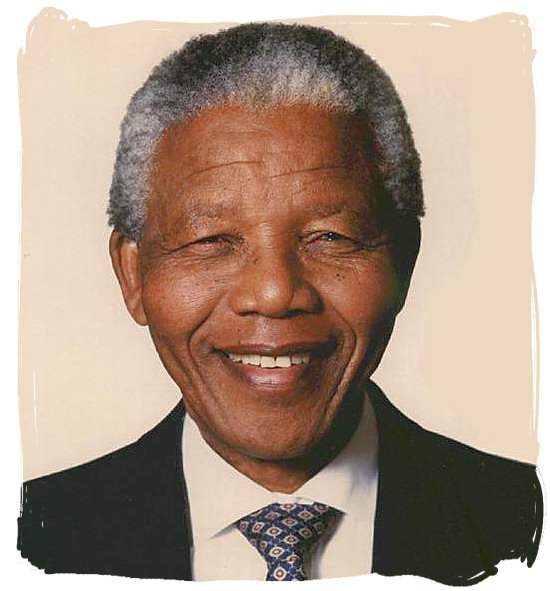 Madiba Nelson Mandela, first State President of the new South Africa from 1994 till 1999 Source: African National Congress - History of Apartheid in South Africa After the Anglo-Boer wars,... On the 31st of May 1910 the two British colonies Natal and the Cape, and the two "Voortrekker" or "Afrikaner" republics Transvaal and Orange Free State, were united into the “Union of South Africa” with one centralized self-government under British supremacy. Apart from the Cape where the coloured people and certain qualifying black people were allowed to remain on the voters roll, the black population were again denied their rights to vote and to participate in government. 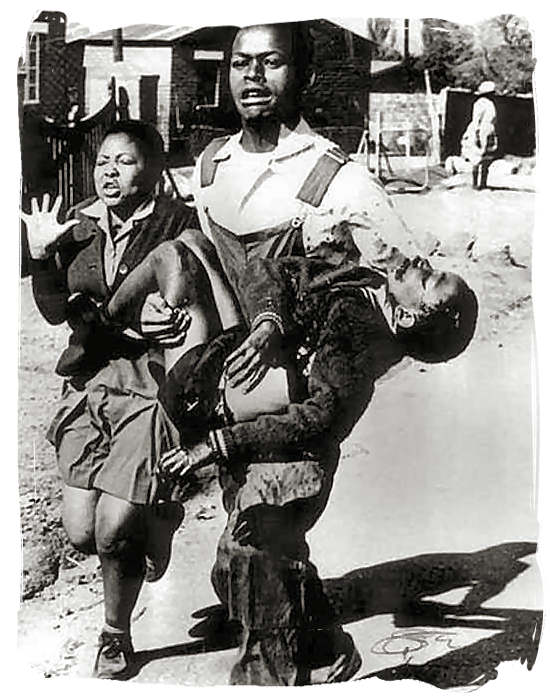 Famous photograph by Sam Nzima of the Soweto Uprising showing a student carrying the body of 12 year old Hector Pieterson, one of the first casualties History of Apartheid in South Africa The "Boer" leaders Louis Botha, Jan Smuts and J.B.M. Hertzog were to play a dominant role in the country's politics for the next half century. As leader of the South African party and first prime minister of the Union of South Africa, General Louis Botha soon took the first repressive measures. He wanted to entrench white supremacy, by introducing the Masters and Servants act, the reservation of skilled work for whites, pass laws, the Native Poll Tax and the 1913 Land Act which reserved 90% of the country for white ownership. Widespread protest by the black people from all over the country, laid the foundation for a unified national organization to represent the interests of the black people of all ethnic groups in the union. On the 8th of January 1912 the South African Native National Congress (SANNC) was founded, known since 1923 as the African National Congress (ANC). They were no militants and all they wanted was equal rights, believing that they would be able to convince the white people of their just course. Strengthening the joint protest against discrimination on the basis of colour, they did not succeed however in making any difference to the life’s of the black people in South Africa. 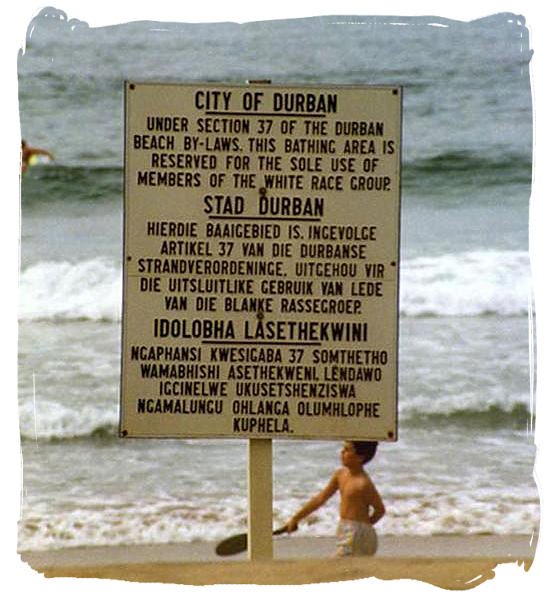 Signboard on a Durban beach History of Apartheid in South Africa << Top of Page Period up to the 2nd world war,... leading up to the second world war, was marked by widespread dissatisfaction among the black people in South Africa. The bitterness that was taking root, showed on the protest campaigns, strikes and labour union activities that were taking place. At its conference in 1923 the African National Congress declared that it believed that it was the intention of the government to permanently enslave all black South Africans. When J.B.M. Hertzog became prime minister in 1824, "Afrikaner" nationalism gained a lot of ground and things became even bleaker. He believed in complete segregation on all levels, territorial, economic, political and educational. The bills that were introduced to achieve this are known as the “hertzog” bills. They caused much misery for the black people. An all African Convention held in Bloemfontein in 1935, denounced the Hertzog bills and requested full and equal rights for all South Africans. 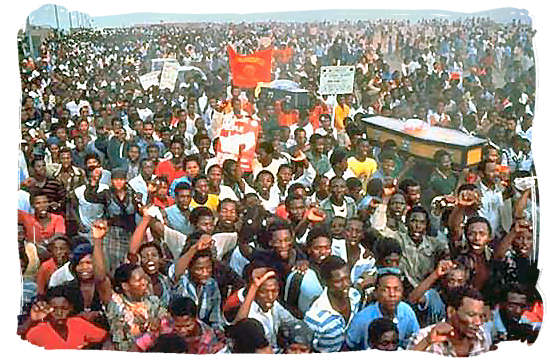 A funeral ceremony and demonstrations rally in 1985 History of Apartheid in South Africa In the early 30’s the National Party of J.B.M. Hertzog and the more moderate South African Party of Jan Smuts were forced into a coalition government, which resulted in the fusion of the two parties, to form the United Party. This led to right-winger D.F. Malan to break away and form a new National Party as a political home for the more extreme "Afrikaner" nationalists. The coalition government fell at the start of the second world war with Jan Smuts winning the power battle and form a government that took South Africa into war. No matter how hard they tried during the 1920's and 1930's, the black people in South Africa remained spectators in the field of politics. They were knocking on a bolted door which no one would open. It was soon realized by them that different methods would have to be devised to get the attention of those in power, marking the start of what was to be nearly 50 years of head-to-head conflict between the African National Congress representing the black people and the National Party government. 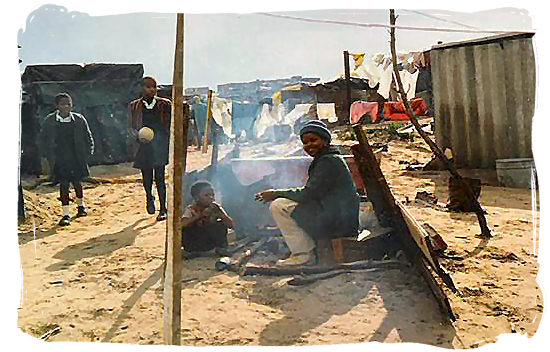 Woman and child in one of the many squatter camps During the second world war, South Africa experienced phenomenal economic growth. The continuous industrial growth led to more urbanisation, causing living conditions in the cities to deteriorate even more. In 1944 the ANC Youth League was formed with Lembede as its president and Nelson Mandela as its secretary. The protest against apartheid would take on new dimensions in the form of mass actions such as national strikes, boycotts and defiance campaigns to name but a few. When the second world war was over, Jan Smuts’s government came to a fall and new elections were held in 1948. Campaigning on the basis of its policy of apartheid, the National Party narrowly defeated Smuts's United party. They formed a coalition government with the Afrikaner Party (AP), with D.F. Malan as prime minister. He immediately began implementing his government’s official ideology of racial segregation. Successive NP administrations formalised and extended the existing system of segregation and denial of rights into the legal system of racial segregation as we know it today and which lasted until the 1990’s. 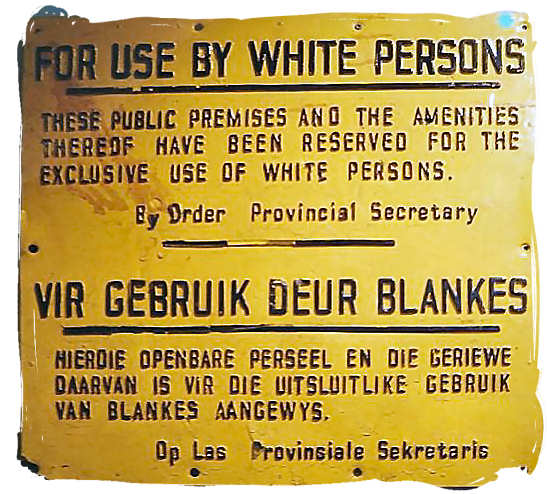 Signboard in English and Afrikaans (Dutch) History of Apartheid in South Africa << Top of Page The Homeland Policy,... An important pillar stone of the apartheid system was its "Homeland" policy, whereby parts of the country were allocated to the different black ethnic groups as a kind of reserve, called "Homeland". Each "Homeland" was to be an independent state with self-government and its own Head of State, under the hegemony of the South African government. The black people that were designated as belonging to such a “Homeland”, would have their South African citizenship replaced with "Homeland" citizenship. This way most of the black people in South Africa would have no more legal claims to participate in the South African government. The 50’s saw the ANC's new strategy of mass resistance in the form of strikes, defiance campaigns and protest marches. The defiance campaign of 1952 under the banner of non-violent resistance to the pass laws and the 1954 campaign against the deliberately inferior Bantu Education system are only but a few examples. On the 26th of June 1955 the ANC’s Freedom Charter, based on the principles of human rights and non-racialism, was signed at the Congress of the People in Soweto. 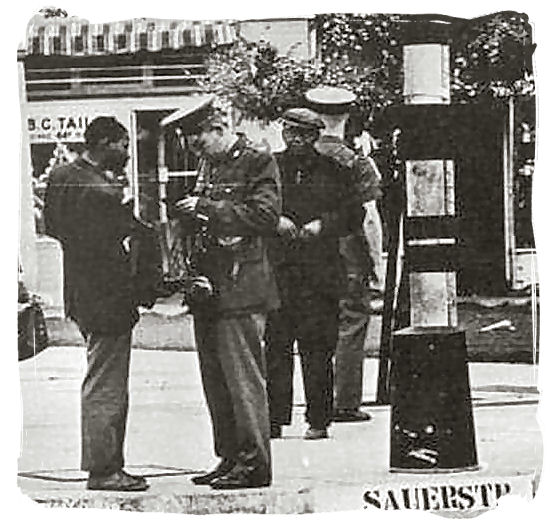 Mid 1970s photograph of police checking passbooks in Johannesburg History of Apartheid in South Africa << Top of Page Period around Sharpville and the Rivonia Trials,... The 60's was a decade of overwhelming repression. Matters came to a head at Sharpeville in March 1960, when 69 anti-pass demonstrators were killed by police. A state of emergency was imposed, detention without trial was introduced and the black political organizations were banned. This led to the ANC abandoning their commitment to non-violent resistance and turn to armed struggle. Top leaders, including members of the newly formed military wing "Umkhonto we Sizwe" (Spear of the Nation), were arrested in 1963. In the "Rivonia trial" eight ANC leaders, including Nelson Mandela were convicted of sabotage and sentenced to life imprisonment. Although initially the black people were left in relative political disarray, the 70’s saw a dramatic resurgence of resistance activity when the revived black trade unions started a wave of strikes in 1973, with a militancy that involved better and more effective organization. June 1976 marked the beginning of a sustained revolt against racial segregation, when the school pupils of Soweto rose up against apartheid education, followed by youth uprisings all over the country. In 1977, news of the brutal death in detention of Steve Biko, leader of the Black Consciousness Movement, reverberated around the world, ending whatever patience the outside world might have had with the South African government. 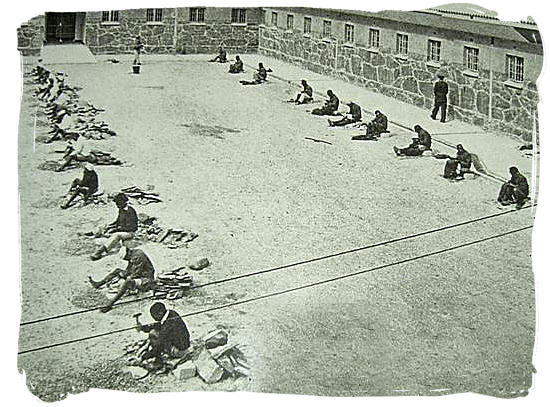 Prisoners chipping stones in the courtyard of Robben Island prison copyright © south-africa-tours-and-travel.com << Top of Page The Decade of Violence,... The 80's will be known as the decade of violence in the struggle for freedom. The P.W. Botha government embarked on a campaign to eliminate the opposition, turning the country into a police state with police, soldiers and armed vehicles patrolling the black townships and squatter camps. The ANC and PAC retaliated by exploding bombs in restaurants, shopping centres and government buildings, killing and maiming many civilians in the process. Black people who did not participate in the resistance actions, were intimidated and victimized in violent ways by their own people. In the end the black people were living in a lawless society, constantly in fear of their lives. The country was in great turmoil and the anti apartheid struggle had succeeded in capturing the attention of the world. As pressures from outside as well as inside the country were building up, economic sanctions were beginning to seriously hurt the economy. Realizing the inevitability of change, President P.W. Botha introduced a series of minor reforms in the direction of racial equality. But he stopped far short of full reform and the black people as well as the international community felt that the changes were only cosmetic. 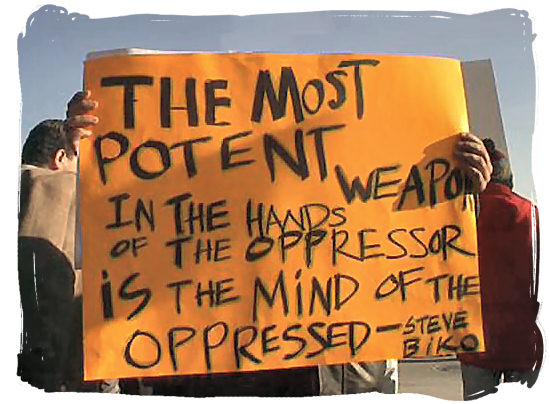 Quotation of Steve Biko, leader of the Black Consciousness Movement, who died in a prison cell on 12 September 1977 << Top of Page The end of Apartheid,... With international pressure continuing to grow and the country on the verge of becoming ungovernable, the South African government was left with no other option then to look for a negotiated settlement, recognizing the demands of the blacks and ending the racial segregation system. In August 1989 Botha resigned as President because of ill health and F.W. de Klerk was sworn in as acting State President. This was to be the turning point towards the end of racial segregation in South Africa. 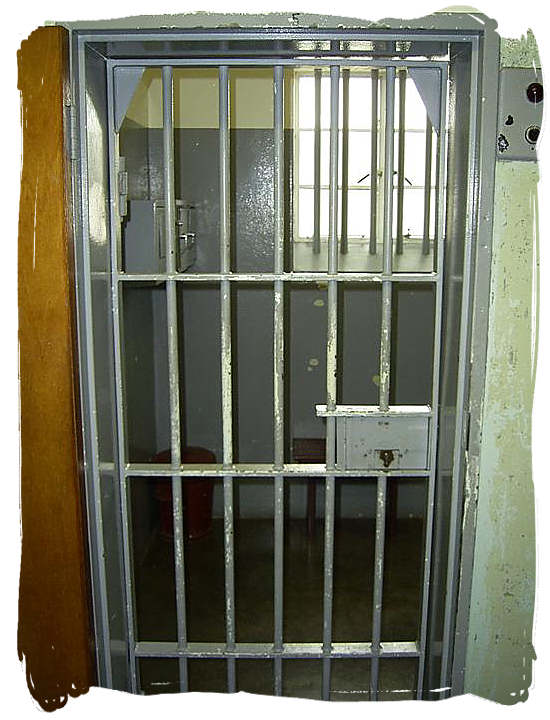 copyright © south-africa-tours-and-travel.com - History of Apartheid in South Africa In February 1990 de Klerk announced the dismantling of the racial segregation system, the un-banning of all liberation movements and the release of political prisoners, in particular Nelson Mandela. After more then a year of preliminary talks, the real negotiations for a changeover of power to a majority government began on the 20th of December 1991 at the Convention for a Democratic South Africa (CODESA). All significant political role players were given the opportunity to take part in the negotiations. 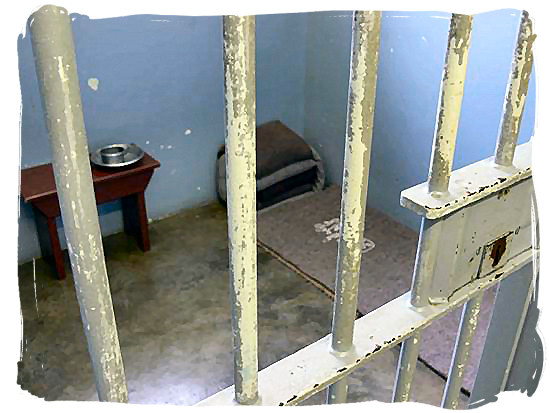 Another view of Nelson Mandela’s prison cell on Robben Island copyright © South-Africa-tours-and-travel.com - History of Apartheid in South Africa During 1993 agreement was reached on a new constitution and the forming of a Government of National Unity, in which all parties polling more then 5% in the elections, would be represented in the cabinet. After 5 years the Government of National Unity would become a straight majority rule government. Although there was considerable political violence by some extremist elements during the negotiation period, particularly in the wake of the killing of Chris Hani, chief of ANC military wing "Umkhonto we Sizwe", the first free elections in South Africa on the 26th of April 1994 went off peacefully, amidst a feeling of goodwill throughout the country. 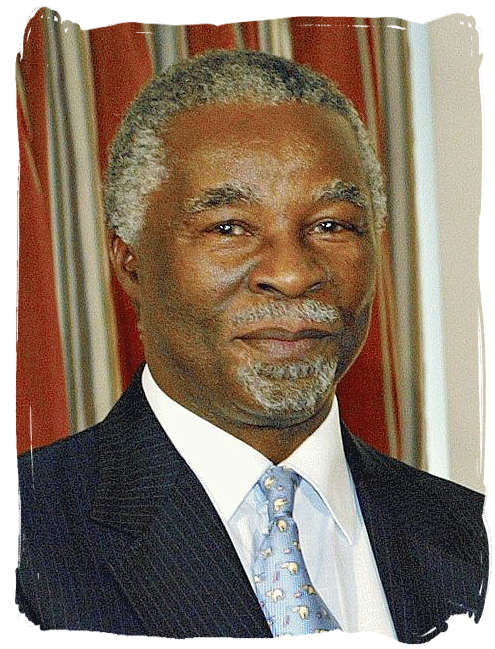 Thabo Mbeki, who succeeded Nelson Mandela as State President of South Africa in June 1999 Source: Antonio Milena/ABr. 27.Oct.2003. - History of Apartheid in South Africa The African National Congress (ANC) won the elections, polling 62,6% of the vote. Nelson Mandela was chosen to head the Government of National Unity as executive State President with F.W. de Klerk and Thabo Mbeki as deputy presidents. In South Africa's second democratic elections on the 2nd of June 1999, the ANC increased its majority marginally. Nelson Mandela retired and Thabo Mbeki followed him up as State President. 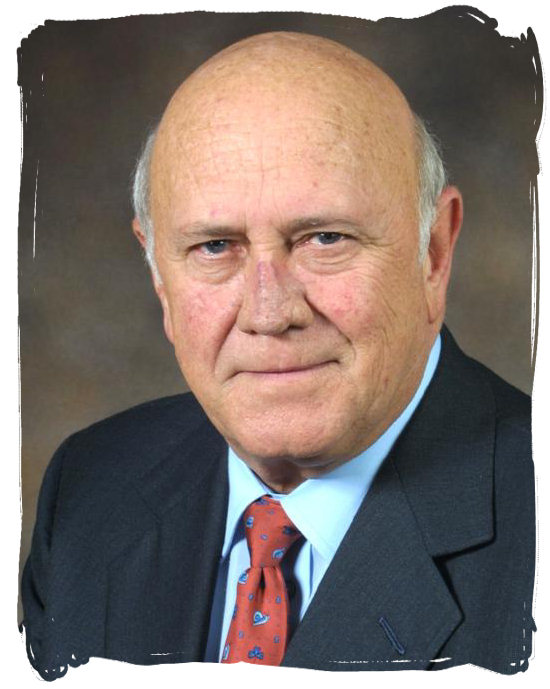 F W de Klerk, State President of South Africa from 1989 till 1994, who ended the apartheid system. From 1994 till 1996 he was deputy State President of South Africa under Nelson Mandela History of Apartheid in South Africa 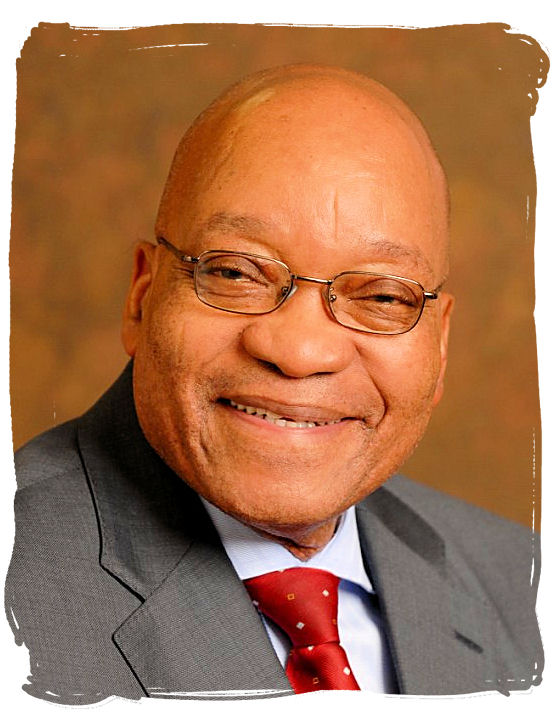 Jacob Gedleyihlekisa Zuma, current president of the Republic of South Africa, who succeeded Thabo Mbeki in May 2009 History of Apartheid in South Africa Top of Page
|
|
|||||||
|
|
||||||||








